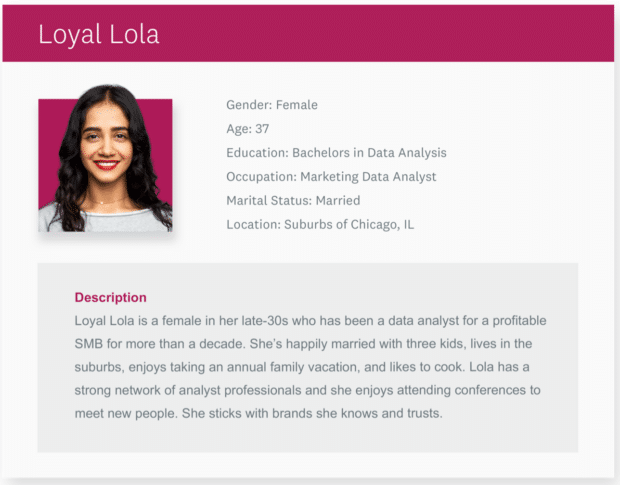As a kid, you may have had an imaginary friend. Social media marketers have them too — only, in this case, they’re called buyer personas or audience personas.
Unlike your imaginary friend, though, these make-believe characters don’t just exist to freak out your parents. They’re an incredibly helpful tool for targeting your ideal customer.
As a social marketer—or any marketer, for that matter—it’s easy to get lost in the details of tracking your latest engagement rates and marketing campaigns. Buyer personas remind you to put your audience’s wants and needs ahead of your own and helps you create content to better target your ideal customer.
Bonus: Get the free template to easily craft a detailed profile of your ideal customer and/or target audience.
What is a buyer persona?
A buyer persona is a detailed description of someone who represents your target audience. This persona is fictional but based on deep research of your existing or desired audience.
You might also hear it called a customer persona, audience persona, or marketing persona.
You can’t get to know every customer or prospect individually. But you can create a customer persona to represent your customer base. (That being said: since different types of customers may buy your products for different reasons, you might need to create more than one buyer persona.)
You’ll give this buyer persona a name, demographic details, interests, and behavioral traits. You’ll understand their goals, pain points, and buying patterns. You can even give them a face using stock photography or illustration if you want — because maybe it’s important for your team to put a face to a name.
Basically, you want to think about and speak about this model customer as if they were a real person. This will allow you to craft marketing messages targeted specifically to them.
Keeping your buyer persona (or personas) in mind keeps the voice and direction of everything consistent, from product development to your brand voice to the social channels you use.
Why use a buyer or audience persona?
Buyer personas keep you focused on addressing customer priorities instead of your own.
Think about your buyer personas every time you make a decision about your social marketing strategy (or overall marketing strategy).
Does a new campaign address the needs and goals of at least one of your buyer personas? If not, you have good reason to reconsider your plan, no matter how exciting it may be.
Once you define your buyer personas, you can create organic posts and social ads that speak directly to the target customers you have defined. Social advertising, in particular, offers incredibly detailed social targeting options that can get your ad in front of exactly the right people.
Build your social strategy based on helping your personas meet their goals, and you’ll build a bond with the real customers they represent. It’s all about creating brand loyalty and trust to, ultimately, streamline your sales process.
How to create a buyer persona, step by step
Your buyer persona shouldn’t just be someone you want to hang out with: they should be based on real-world data and strategic goals. Here’s how to craft a fictional customer that’s the perfect fit for your real-world brand.
1. Do thorough audience research
It’s time to dig deep. Who are your existing customers? Who is your social audience? Who are your competitors targeting? For a more in-depth look at these concepts, check out our complete guide to audience research, but in the meantime…
Compile audience data from your social media analytics (especially Facebook Audience Insights), your customer database and Google Analytics to narrow in on details like:
- Age
- Location
- Language
- Spending power and patterns
- Interests
- Challenges
- Stage of life
- For B2B: The size of businesses and who makes purchasing decisions
It’s also a good idea to make sure you understand which social channels your audience uses. Find out where they already spend time online, using tools like Hootsuite Insights, Keyhole.co and Google Analytics.
You can also scope out who competitors are targeting using tools like Buzzsumo and Hootsuite’s search streams.
For more detailed strategies, check out our full post on how to conduct competitor research using social tools.
2. Identify customer goals and pain points
Your audience’s goals might be personal or professional, depending on the kinds of products and services you sell. What motivates your customers? What’s their end game?
On the flip side of that are their pain points. What problems or hassles are your potential customers trying to solve? What’s holding them back from success? What barriers do they face in reaching their goals?
Your sales team and customer support department are great ways to find answers to these questions, but another key option is to engage in some social listening and social media sentiment analysis.
Setting up search streams to monitor mentions of your brand, products, and competitors gives you a real-time look into what people are saying about you online. You can learn why they love your products, or which parts of the customer experience are just not working.
3. Understand how you can help
Now that you have a grasp on your customers’ goals and struggles, it’s time to think about how you can help. That means thinking beyond just the features and analyzing the true benefits of your product or service.
A feature is what your product is or does. A benefit is how your product or service makes your customer’s life easier or better.
Consider your audience’s main purchasing barriers, and where your followers are in their buying journey? And then ask yourself: How can we help? Capture the answer in one clear sentence.
4. Create your buyer personas
Gather all of your research and start looking for common characteristics. As you group those characteristics together, you’ll have the basis of your unique customer personas.
Give your buyer persona a name, a job title, a home, and other defining characteristics. You want your persona to seem like a real person.
For example, say you identify a core customer group as 40-year-old, professionally successful city-dwelling women with no kids and a passion for great restaurants. Your buyer persona might be “High-Achiever Haley.”
- She is 41 years old.
- She goes to spin class three times a week.
- She lives in Toronto and is the founder of her own PR firm.
- She owns a Tesla.
- She and her partner go on two international vacations a year and prefer to stay at boutique hotels.
- She’s a member of a wine club.
You get the gist: this isn’t just a list of characteristics. This is a detailed, specific description of one potential customer. It allows you to think about your future buyer in a human way, so they’re not just a collection of data points. These things may not necessarily be true of every buyer in your audience, but they help represent an archetype in a tangible way.
Aim for about the amount of information you would expect to see on a dating site (though don’t forget to include pain points… which wouldn’t necessarily fly on Bumble).
As you flesh out your customer personas, be sure to describe both who each persona is now and who they want to be. This allows you to start thinking about how your products and services can help them get to that place of ambition.
Buyer persona examples
Brands can create and share their buyer personas with the team in a variety of different ways. It might be a list of bullet points; it could be a robust, multi-paragraph story. It might include a stock photo or illustration. There’s no wrong way to format these reference docs: do it in whatever way helps your team understand your customers (and target personas) best.
A Beauty Conscious, Magazine-Loving Mom Named Karla
Here’s one example from UX designer James Donovan. It fleshes out a buyer persona for a fictional customer named Karla Kruger, including details about her job, age, and demographic — and of course, her pain points and goals. She’s 41 years old and pregnant, and we have vivid details about her product preferences and beauty routine.
What’s interesting about this example is that it also includes her media consumption and favorite brands, too. Details are key for bringing a customer persona to life, so get specific!
Here, we also see where “Karla” falls on various spectrums of brand loyalty, social influence, and price sensitivity. If these sorts of details are important to know about your customer, seek that information out in your research phase and include it in your persona template!
A Brand-Loyal Suburban Home Cook
This example from Survey Monkey of a buyer persona breathes life into a fictional data analyst. We learn about her education and where she lives, but also about her interests and passions — she likes to cook and travel, values her relationships, and is brand-loyal.
If this were your company’s prototypical client, how would that impact your marketing strategy or product offerings? Having a clearly defined buyer persona helps frame every decision you make.
A Dog-Loving Young Professional
For this buyer persona, created by digital marketing agency Single Grain, we learn about Tommy Technology’s income and love life, as well as his career struggles. Including some quotes (either repurposed from real customers or invented) can help give a character like this a voice, too.
Buyer persona template
Ready to get started concocting your first buyer persona? Our free buyer persona template in Google Docs is a great place to kick things off:
Bonus: Get the free template to easily craft a detailed profile of your ideal customer and/or target audience.
To use the template, click the “File” tab and select “Make a copy” from the drop-down menu. Now you’ve got your very own version to fill out as you see fit.
Think about your buyer personas every time you make a decision about your social media content and overall marketing strategy. Do right by these personas, and you’ll build a bond with the real customers they represent—boosting sales and brand loyalty.
Save time on social media with Hootsuite. From a single dashboard, you can manage all your accounts, engage the audience, measure results, and more. Try it free today.
Do it better with Hootsuite, the all-in-one social media tool. Stay on top of things, grow, and beat the competition.
Free 30-Day Trial







